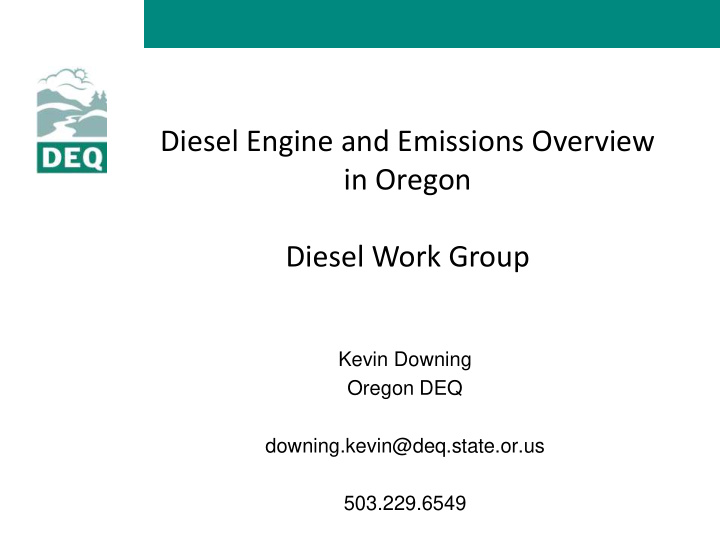



Diesel Engine and Emissions Overview in Oregon Diesel Work Group Kevin Downing Oregon DEQ downing.kevin@deq.state.or.us 503.229.6549
Diesel and Air Quality
Particle Size Matters
Diesel Engines and Air Quality
Diesel Engines and Air Quality Reduction Targets To Meet Diesel PM Benchmark 89-92 % Depending upon the source category
Climate Change Agents From Hansen and Saito, 2001
Relative Radiative Forcing BC v. CO 2
Short Lived Climate Forcings Radiative Forcing Temperature Response
Climate Change Camilo Mora et al., The projected timing of climate departure from recent variability, Nature, October 2013
Black Carbon Project Benefits Repowering engines saves fuel, reduces emissions • 2.4 T PM • 32,000 gallons fuel Climate Change Benefit CO2 21% BC 79%
Oregon Clean Diesel Initiative • Burn Cleaner Fuel • Burn Fuel Cleaner • Burn Less Fuel
Clean Diesel Initiative
Burn Cleaner Fuel • ULSD • Biodiesel • Renewable Diesel • Natural Gas • Propane • Electric
Burn Fuel Cleaner • Catalyst oxidizes CO, HC to harmless gases • Trap prevents particulate emissions to open air; catalyst oxidizes the particulate, regenerating the trap • Can reduce total particulate emissions by up to 95 % • Better toxic reduction (carbonyl & PAHs) than CNG
Burn Less Fuel Improving fuel economy Reducing Idling Upgrading engines to reduce fuel consumption
Clean Diesel Projects
Cost Effectiveness of Alternative Controls From: Alternative Diesel Fuel Symposium, August 2003, California Energy Commission
Port Emission Reduction Grant Replace 23 trucks Retrofit 3 cargo handlers Cost $ 296,000 Benefit $1.2 million
Projected Diesel PM Risk in Oregon 30 25 Cancer risk per million 20 Reduce risk to 1 in 1 million by 2017 15 10 5 0 2017 1996 2002 2010 2018 2026
Oregon Sources of Diesel PM - 2011 DEQ 2011 Emission Inventory
Oregon Heavy Duty Truck Fleet Multi state 320,090 2008 and newer Oregon based 54,952 2007 and older
Oregon Heavy Duty Truck Fleet Oregon based 2008 and newer 54,952 Multi- state 320,090 2007 and older
Oregon Non- road Diesel ≥ 25 HP By Emission Tier EPA NONROAD Model
Clean Diesel Challenges • Benefits are disbursed and in the future • Solutions come at a cost • Can require substantial effort • Legacy problem • Voluntary vs. regulatory
Clean Diesel Opportunities • Addresses a serious need • Solution readily available • Cost effective • Substantial gains in protecting public health and the environment
Recommend
More recommend